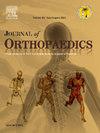用于脊柱肿瘤手术的患者专用 3D 打印 PEEK 植入物
IF 1.5
Q3 ORTHOPEDICS
引用次数: 0
摘要
Aims & objectives本研究评估了脊柱肿瘤患者使用三维打印聚醚醚酮(PEEK)患者特异性植入物(PSI)进行椎体置换(VBR)的可行性和临床结果。研究问题的重点是 12 个月内的术后效果、植入物整合和并发症。方法对 2022 年 4 月至 2023 年 6 月期间使用 PEEK 3D VBR 进行肿瘤切除后脊柱重建的五名患者进行了单中心回顾性病例系列分析。纳入标准为胸椎/腰椎肿瘤、肿瘤切除后使用 PEEK 3D VBR 重建、随访超过 12 个月。PEEK植入物采用医用级PEEK熔丝制造。患者数据包括人口统计学、病史、肿瘤特征和手术结果。放射学评估包括骨性融合、局部角度变化和节段高度稳定性。结果平均随访时间为 19.2 个月。所有患者均存活,其中一人局部复发。术后造影显示局部角度减小,随访期间无明显变化。节段高度保持稳定,未发现 PEEK 3D VBR 下沉或硬件故障。结论将 PEEK 3D 打印 PSI 用于脊柱肿瘤患者的 VBR 具有良好的可行性和临床效果,在 12 个月的时间里,植入物整合稳定,并发症极少。建议进行更大规模的研究来验证这些发现。本文章由计算机程序翻译,如有差异,请以英文原文为准。
Patient-specific 3D-Printed PEEK implants for spinal tumor surgery
Aims & objectives
This study evaluates the feasibility and clinical outcomes of using 3D-printed polyetheretherketone (PEEK) patient-specific implants (PSI) for vertebral body replacement (VBR) in patients with spinal tumors. The research question focuses on postoperative results, implant integration, and complications over a 12-month period.
Methods
A single-center, retrospective case series analyzed five patients who underwent spinal reconstruction after tumor resection using PEEK 3D VBR between April 2022 and June 2023. Inclusion criteria were thoracic/lumbar spinal tumors, tumor resection with PEEK 3D VBR reconstruction, and follow-up exceeding 12 months. PEEK implants were created using fused filament fabrication from medical-grade PEEK. Patient data included demographics, medical history, tumor characteristics, and surgical outcomes. Radiological evaluations assessed bony fusion, local angle changes, and segment height stability. Descriptive statistical analyses were performed using R software.
Results
The mean follow-up duration was 19.2 months. All patients remained alive, with one experiencing local recurrence. Postoperative imaging showed a decrease in local angle with no significant changes during follow-up. Segment heights remained stable, and no PEEK 3D VBR subsidence or hardware failure was observed. Bony fusion was observed in all patients.
Conclusions
The use of PEEK 3D printed PSI for VBR in spinal tumor patients demonstrates promising feasibility and clinical outcomes, with stable implant integration and minimal complications over a 12-month period. Further studies with larger cohorts are recommended to validate these findings.
求助全文
通过发布文献求助,成功后即可免费获取论文全文。
去求助
来源期刊

Journal of orthopaedics
ORTHOPEDICS-
CiteScore
3.50
自引率
6.70%
发文量
202
审稿时长
56 days
期刊介绍:
Journal of Orthopaedics aims to be a leading journal in orthopaedics and contribute towards the improvement of quality of orthopedic health care. The journal publishes original research work and review articles related to different aspects of orthopaedics including Arthroplasty, Arthroscopy, Sports Medicine, Trauma, Spine and Spinal deformities, Pediatric orthopaedics, limb reconstruction procedures, hand surgery, and orthopaedic oncology. It also publishes articles on continuing education, health-related information, case reports and letters to the editor. It is requested to note that the journal has an international readership and all submissions should be aimed at specifying something about the setting in which the work was conducted. Authors must also provide any specific reasons for the research and also provide an elaborate description of the results.
 求助内容:
求助内容: 应助结果提醒方式:
应助结果提醒方式:


